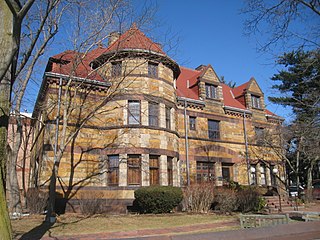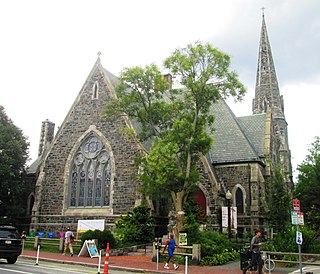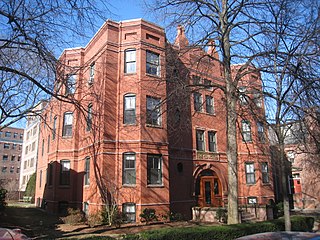
Harvard Yard, in Cambridge, Massachusetts, is the oldest part of the Harvard University campus, its historic center and modern crossroads. It contains most of the freshman dormitories, Harvard's most important libraries, Memorial Church, several classroom and departmental buildings, and the offices of senior University officials including the President of Harvard University.

Harvard Square is a triangular plaza at the intersection of Massachusetts Avenue, Brattle Street and John F. Kennedy Street near the center of Cambridge, Massachusetts, United States. The term "Harvard Square" is also used to delineate the business district and Harvard University surrounding that intersection, which is the historic center of Cambridge. Adjacent to Harvard Yard, the historic heart of Harvard University, the Square functions as a commercial center for Harvard students, as well as residents of western Cambridge, the western and northern neighborhoods and the inner suburbs of Boston. The Square is served by Harvard station, a major MBTA Red Line subway and a bus transportation hub.

The Edwin Abbot House, also known as the Zabriskie House, is an historic house at 27 Garden Street in Cambridge, Massachusetts. Built in 1889 to a design by Longfellow, Alden & Harlow, it is a prominent local example of residential Richardsonian Romanesque architecture. It has served as the principal building of the Longy School since 1937. It was listed on the National Register of Historic Places in 1979, and included in the Follen Street Historic District in 1986.

The Bigelow Street Historic District encompasses a uniform collection of 19th century houses on most of the length of Bigelow Street in Cambridge, Massachusetts, just northwest of Central Square. Bigelow Street was laid out in 1868, and the street was almost completely built out by 1874, resulting in a fairly uniform streetscape of Second Empire architecture. The district was added to the National Register of Historic Places in 1982.

The Cambridge Common Historic District is a historic district encompassing one of the oldest parts of Cambridge, Massachusetts. It is centered on the Cambridge Common, which was a center of civic activity in Cambridge after its founding in 1631. It was the site of the election for governor of the Massachusetts Bay Colony in 1636, and was a military barracks site during the American Revolutionary War. The common was gradually reduced in size to its present roughly triangular shape, and surrounded by buildings in the 18th and 19th centuries. In 1973 a historic district encompassing the extant common and everything within 100 feet (30 m) of it was listed on the National Register of Historic Places. In 1987 the district was amended to rationalize the boundary, which overlapped adjacent districts and included portions of some buildings.

North Avenue Congregational Church is a historic church meetinghouse at 1801 Massachusetts Avenue in Cambridge, Massachusetts. It was completely renovated in 2015 to become a library for Lesley University. The former church now forms part of what is now the Lunder Arts Center complex.

The Old Cambridge Baptist Church is a historic American Baptist church at 400 Harvard Street in Cambridge, Massachusetts.

The Building at 104–106 Hancock Street is an historic cottage in Cambridge, Massachusetts. Built in 1839, it is a significant local example of transitional Greek Revival/Gothic Revival architecture, and one of the earliest houses built after the subdivision of Dana Hill. It was listed on the National Register of Historic Places in 1983.

The Richard Hapgood House is an historic multiunit house at 382-392 Harvard Street in Cambridge, Massachusetts. The six-unit wood-frame building was built in 1889, and represents an unusual instance of Queen Anne styling applied to such a large structure. It was built at a time when housing stock was transitioning from small types of multiunit housing to larger formats such as tenements and apartment houses.

The Harvard Houses Historic District is a historic district encompassing seven of Harvard College's residential houses. The district is roughly bounded by Mt. Auburn, Grant, and Cowperwaite Streets, Banks Street and Putman Avenue, Memorial Drive, and JFK Street in Cambridge, Massachusetts. The contributing buildings to the district are predominantly residential dormitory buildings which were constructed between 1913 and 1930, and are Georgian Revival in style. There are three small residential buildings which were built in the 18th and 19th centuries, and a number of non-contributing later buildings, including among others the towers of Leverett House and the modern portion of Quincy House at 58 Plympton Street. The buildings are an imposing presence in the streetview of Memorial Drive between Western Avenue and the Anderson Memorial Bridge, but their massing is interrupted by mature tree plantings, and they are organized to provide courtyards and quadrangles in the interior of the district.

The Lowell is an historic triple decker apartment house on 33 Lexington Avenue in Cambridge, Massachusetts. Built in 1900 to a design by local architect John Hasty, it is a rare multiunit building in the Brattle Street area outside Harvard Square. The Colonial Revival building has a swan's neck pediment above the center entry, which is echoed above the central second story windows. Doric pilasters separate the bays of the front facade, and the building distinctively has side porches, giving it added horizontal massing. It was built before the decision was made to locate the electrified trolleys on Mount Auburn Street instead of Brattle, a decision that reduced interest in building more multiunit housing in that area.

The Old Cambridgeport Historic District is a historic district along Cherry, Harvard and Washington Streets in Cambridge, Massachusetts. It contains some of the oldest surviving houses north of Massachusetts Avenue in the Cambridgeport section of the city. It includes the entire block of Cherry Street between Harvard and Washington Streets, as well as a few buildings on those two streets. The oldest houses are the Samuel Fay House and the Margaret Fuller House.

Ware Hall is an historic residential apartment building at 383 Harvard Street in Cambridge, Massachusetts. It was designed by local architect George Fogerty and built in 1893. Fogerty was also the architect of Claverly Hall, a similar building, on Mount Auburn Street. This five story brick Classical Revival building is a rare example of an apartment house built in Mid Cambridge that was designed to cater to Harvard University students. Apartment blocks of this quality were generally built closer to the Harvard campus, so this one stands out when compared to other apartment house in its immediate surroundings.

The University Museum is a historic building that houses several museums belonging to Harvard University. The building is located at 24-28 Oxford Street and 11-25 Divinity Avenue in Cambridge, Massachusetts. It houses both the Harvard Museum of Natural History at 26 Oxford Street, and the Peabody Museum of Archaeology and Ethnology at 11 Divinity Avenue, as well as several departments of Harvard's Museum of Comparative Zoology and the Mineralogical & Geological Museum.

The Stanstead is a historic apartment building located at 19 Ware Street in Cambridge, Massachusetts. The three-story Richardsonian Romanesque building was built in 1887, and is an uncommon brick rendition of a triple=decker, more typically a wood-frame construction, that was just becoming popular in Cambridge. The architects, J. R. & W. P. Richards, also designed The Jarvis, another early brick apartment house in the city.

The First Universalist Church is a historic Universalist Church building at 125 Highland Avenue in Somerville, Massachusetts. The Romanesque church building was built between 1916 and 1923 to a design by Ralph Adams Cram, and is the only example of his work in Somerville. The building was listed on the National Register of Historic Places in 1989. It is currently owned by the Highland Masonic Building Association, and is the home of King Solomon's Lodge AF & AM, the builders of the Bunker Hill Monument.

The former First Unitarian Church is a historic church building at 130 Highland Avenue in Somerville, Massachusetts. The stone church was built in 1894 for a Unitarian congregation. It was designed by Hartwell & Richardson and is a good example of Richardsonian Romanesque design. The building presently (2022) houses the Mission Church of Our Lord Jesus Christ.

The buildings at 35–37 Richardson Avenue are historic rowhouses in Wakefield, Massachusetts. These two rowhouses, built c. 1912–15, are among the earliest apartment blocks built in the town. They were built by Solon O. Richardson, Jr. on a portion of his estate. The buildings were listed on the National Register of Historic Places in 1989.

Mount Vernon Triangle is a neighborhood and community improvement district in the northwest quadrant of Washington, D.C. The neighborhood is located adjacent to Mount Vernon Square. Originally a working-class neighborhood established in the 19th century, present-day Mount Vernon Triangle experienced a decline in the mid-20th century as it transitioned from residential to commercial and industrial use.
The John Winthrop Chambers, also known historically as the Brooks Apartments, is a historic apartment house at 78-80 Porter Road in Cambridge, Massachusetts. The building was listed on the National Register of Historic Places in 2023. Built in 1915, it is a significant local example of residential Colonial Revival architecture, and an early example of the large courtyard-style apartment block in the Porter Square neighborhood of Cambridge. It was listed on the National Register of Historic Places in 2023.






















